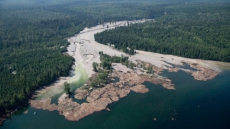VANCOUVER — Everyone celebrating Canada Day on the B.C. legislature's front lawn in 2013 could have died or been injured if three shrapnel-packed pressure-cooker bombs had detonated, a B.C. Supreme Court jury heard on the final day of the Crown's submissions.
An RCMP explosives expert who built the fake explosives for accused terrorists John Nuttall and Amanda Korody painted a grim picture of what could have happened had they been real.
"Blast pressure is what we would consider the most dangerous in close proximity to an explosion because it can move through you and simply turn your organs into mush," Const. Peter Cucheran told jurors on Tuesday.
The pressure waves emanating from the explosion would have been enough to cause death or serious injury within 30 metres, he said.
The jury has already heard the couple hid what they thought were homemade pressure-cooker bombs, containing C4 plastic explosives, in flower planters at the legislature but didn't know they were working with undercover police.
Cucheran said fragments or shrapnel that spread from a detonation site can be equally as deadly at further distances.
"Pieces of the pressure cooker ... are likely going to be flat or mangled pieces of metal, which are going to catch wind and therefore slow down," he said. "Whereas a nail, for instance, is going to travel likely further."
The furthest edge of the front lawn of the legislature is about 150 metres from the alleged detonation sites, the Crown has told the court.
Cucheran said the minimum safe distance from the most powerful of the three bombs allegedly hidden by the couple was 250 metres.
Footage played in court earlier Tuesday showed Mounties detonating the same model of homemade pressure-cooker explosive that Nuttall and Korody are accused of using for their alleged plot.
Cucheran narrated the scene to the jury as a pressure cooker packed with nails, metal washers and more than two kilograms of C4 obliterated a surrounding ring of plywood boards.
The detonation took place inside a sand-filled compound lined with two tiers of concrete blocks, located at a police explosives range in the Vancouver area.
Cucheran said he couldn't recall whether he saw any shrapnel embedded in the sheets of plywood in the aftermath of the staged explosion.
"Everything that I saw (had) holes through it," he said.
All that was left in the compound, which was caked with dirt following the blast, was a smoking crater and wood debris, the video showed.
Jurors watched a second video of a pressure cooker filled with gunpowder exploding. Court previously heard Nuttall tell an undercover officer that he would use gunpowder to build a bomb if he failed to acquire C4.
The blast from the second explosive did not appear as powerful as the C4 bomb and failed to even topple the surrounding plywood boards.
After the Crown closed its case, the jury was asked not to return to court on Wednesday.






